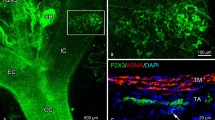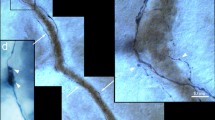Summary
Observations on silver-impregnated sections through the brains of human beings, dogs and guinea pigs show an abundant innervation of the pial arteries. On the basis of the lightmicroscopical findings, two systems of nerve fibres can be distinguished:
-
1.
A plexus of fine, nonmyelinated nerve fibres originating from thicker fibre bundles of the adventitia. The fine fibres arborize on the muscle cells of the media of larger and smaller arteries.
-
2.
Bundles of myelinated and nonmyelinated fibres, to be found in the periadventitia of larger blood vessels. It is not clear whether there is a connection between these two systems.
Electronmicroscopical investigations of pial arteries of the Rhesus monkey confirm the lightmicroscopical observations. In the adventitia of the blood vessels there are numerous small bundles of nonmyelinated nerve fibres, embedded in Schwann cytoplasm. As the distance between nerve fibres and muscle cells of the media decreases, accumulations of granular and agranular vesicles are to be seen in the nerve fibres. At the same time, the nerve fibres lose their investment of Schwann cytoplasm. Both these morphological characteristics designate the “neuro-effector area” of the mainly adrenergic vascular nerves. The gap between these axons — which are regarded as functional terminals — and the muscle cells varies between 0.7 and 8 μ. In the case of small arteries and arterioles, similarly accompanied by vascular nerves, the gap diminishes to 0.2 μ.
Zusammenfassung
Beobachtungen an silberimprägnierten Gehirnschnitten von Mensch, Hund und Meerschweinchen zeigen die reichhaltige Innervation der Piaarterien. Auf Grund der lichtmikroskopischen Befunde lassen sich zwei verschiedene Nervenfasersysteme unterscheiden:
-
1.
Ein Geflecht aus feinsten, markarmen Nervenfasern, das sich auf den Muskelfasern der Media größerer und kleinerer Arterien verästelt und seinen Ausgang von breiteren Faserbündeln der Adventitia nimmt.
-
2.
Bündel aus markreichen und markarmen Nervenfasern, die in der Periadventitia größerer Gefäße anzutreffen sind. Eine Verknüpfung beider Systeme ist nicht eindeutig festzustellen.
Elektronenmikroskopische Untersuchungen an Piaarterien des Rhesusaffen bestätigen die lichtmikroskopische Einteilung der im Gefäßbereich anzutreffenden nervösen Elemente. In der Adventitia der Gefäße trifft man auf zahlreiche kleine Bündel markarmer Nervenfasern, eingebettet in Schwannsches Cytoplasma. Mit abnehmender Entfernung zwischen Nervenfasern und Muskelzellen der Media häufen sich in den Nervenfasern granuläre und agranuläre Vesikel. Gleichzeitig werden die Nervenfasern von der sie umgebenden Hülle Schwannschen Cytoplasmas freigegeben. Beide morphologischen Merkmale charakterisieren das „Neuroeffektorgebiet“ der hauptsächlich adrenergen Gefäßnerven. Der Abstand dieser als funktionelle Endigungen zu bezeichnenden Axone zu den Muskelzellen variiert zwischen 0,7 und 8 μ. Bei kleinen Arterien und Arteriolen, die ebenfalls von Gefäßnerven begleitet werden, verringert sich die Distanz auf 0,2 μ.
Similar content being viewed by others
Literatur
Bloom, W., andD. W. Fawcett: A textbook of histology, 9th edition. Philadelphia-London-Toronto: W. B. Saunders Co. 1968.
Bodian, D.: The generalized vertebrate neuron. Conventional terminology of neuron structure lags behind current functional-anatomical concepts. Science137, 323–326 (1962).
Busch, E.: The innervation of intracranial blood vessels. Acta psychiat. (Kbh.)13, 131–158 (1938).
Chorobski, S., andW. Penfield: Cerebral vasodilator nerves and their pathway from the medulla oblongata with observations of the pial and intracerebral vascular plexuses. Arch. Neurol.28, 1257–1289 (1932).
Cobb, S., andJ. E. Finesinger: The vagal pathway of the vasodilator impulses. Arch. Neurol.28, 1243–1256 (1932).
Dahl, E., andE. Nelson: Electron microscopic observations on human intracranial arteries. Arch. Neurol. (Chic.)10, 158–164 (1964).
Devine, C. E., andF. O. Simpson: The fine structure of vascular sympathetic neuromuscular contacts in the rat. Amer. J. Anat.121, 153–173 (1967).
Dowgjallo, N. D.: Beiträge zur Lehre von der Innervation des peripheren Blutgefäßsystems. Z. Anat. Entwickl. Gesch.97, 9–54 (1932).
Eccles, J. C.: The physiology of nerve cells. Baltimore: John Hopkins Press 1957.
Elfvin, L. G.: The ultrastructure of unmyelinated fibers in the splenic nerve of the cat. J. Ultrastruct. Res.1, 428–454 (1958).
—: Electronmicroscopic investigation of filament structures in unmyelinated fibers of cat splenic nerve. J. Ultrastruct. Res.5, 51–64 (1961).
Gansler, H.: Phasenkontrast- und elektronenmikroskopische Untersuchungen zur Innervation der glatten Muskulatur. Acta neuroveg.(Wien)22, 192–211 (1961).
Grigorjewa, T.: Histologische Untersuchungen über die Innervation der Hirngefäße. Z. mikr. anat. Forsch.28, 418–426 (1932).
Hagen, E.: Mikroskopische Beobachtungen über die Innervation der Gefäße in der Substanz des Zwischenhirns und der Pia mater. Z. Anat. Entwickl.-Gesch.118, 223–236(1954).
—: Anatomie des vegetativen Nervensystems. Akt. Fragen Psychiat. Neurol.3, 1–73 (1966).
—: Zur Innervation der Haut. In:Jadassohns Handbuch der Haut- und Geschlechtskrankheiten, Erg.-Bd. I/1, S. 377–429 (Hrsg.:O. Gans undG. K. Steigleder). Berlin-Heidelberg-New York: Springer 1968.
Jabonero, V.: Der anatomische Aufbau des peripheren neurovegetativen Systems. Acta neuroveg. (Wien), Suppl. IV (1953).
Kautzky, R.: Ein Grundplan der cerebrospinalen Innervation der Hirnhäute und Hirngefäße. Z. Anat. Entwickl.-Gesch.115, 570–583 (1951).
Legait, E., etA. Dollander: Innervation des vaisseaux de la base du cerveau chez le cobaye. C. R. Ass. Anat. (34. Réun.)1948, 325–328.
Moffat, D. B.: The fine structure of the blood vessels of the renal medulla with particular reference to the control of the medullary circulation. J. Ultrastruct. Res.19, 532–545 (1967).
Newton, D.: Über die Leistung der Silberimprägnationsmethode nach Richardson zur Darstellung des vegetativen Nervensystems an der Haut, am Darm und an der Gallenblase. Acta anat. (Basel)58, 201–216 (1964).
Nielsen, K. C., andC. Owman: Adrenergic innervation of pial arteries related to the circle of Willis in the cat (fluorescent microscopy). Brain Res.6, 773–776 (1967).
Pease, D. C., andS. Molinari: Electron microscopy of muscular arteries, pial vessels of the cat and monkey. J. Ultrastruct. Res.3, 447–468 (1960).
Penfield, W.: Intracerebral vascular nerves. Arch. Neurol.27, 30–44 (1932).
Rhodin, J. A. G.: Fine structure of vascular walls in mammals. Physiol. Rev.42, 48–81 (1962).
Richardson, K. C.: Studies on the structure of autonomic nerves in the small intestine, corellating the silver-impregnated image in light microscopy with the permanganate fixed ultrastructure in electron microscopy. J. Anat. (Lond.)94, 457–472 (1960).
—: The fine structure of autonomic nerve endings in smooth muscle of the rat vas deferens. J. Anat. (Lond.)96, 427–442 (1962).
—: The fine structure of the albino rabbit iris with special reference to the identification of adrenergic and cholinergic nerves and nerve endings in its intrinsic muscles. Amer. J. Anat.114, 173–205 (1964).
Robertis, E. de: Ultrastructure and cytochemistry of the synaptic region: The macromolecular components involved in nerve transmission are being studied. Science156, 907–914 (1967).
—: Ultrastructure- and function in some neurosecretory systems. Memoirs of the Society for Endocrinology No. 12. In: Neurosecretion (ed,H. Heller andR. B. Clark). London and New York: Acadamic Press 1962.
Ruska, H., u.C. Ruska: Licht und Elektronenmikroskopie des peripheren neurovegetativen Systems im Hinblick auf die Funktion. Dtsch. med. Wschr.86, 1697–1701, 1770–1772 (1961).
Samarasinghe, D. D.: The innervation of the cerebral arteries in the rat: an electron microscope study. J. Anat. (Lond.)99, 815–828 (1965).
Stöhr, Ph., Jr.: Über die Innervation der Pia mater und des Plexus chorioideus des Menschen. Z. Anat. Entwickl.Gesch.63, 565–607 (1921).
—: Beobachtungen über die Innervation der Pia mater des Rückenmarkes und der Telae chorioideae des Menschen. Z. Anat. Entwickl.-Gesch.64, 555–567 (1922).
—: Mikroskopische Anatomie des vegetativen Nervensystems. In: Handbuch der mikroskopischen Anatomie des Menschen (hrsg.W. Bargmann, Bd. IV/5/V. Berlin-Göttingen-Heidelberg: Springer 1957.
Thaemert, J. C.: The ultrastructure and disposition of vesiculated nerve processes in smooth muscle. J. Cell Biol.16, 361–377 (1963).
Trossmann, G.: Ein Beitrag zur feineren Innervation des weiblichen Urogenitaltraktes beim Hund. Diss. Med. Fakultät Bonn 1966.
Verity, M. A., andJ. A. Bevan: Fine structural study of the terminal effector plexus, neuromuscular and intermuscular relationships in the pulmonary artery. J. Anat. (Lond.)103, 49–63 (1968).
Zypen, E. van der: Elektronenmikroskopische Befunde an der Endausbreitung des vegetativen Nervensystems und ihre Deutung. Acta anat. (Basel)67, 481–515 (1967).
Author information
Authors and Affiliations
Rights and permissions
About this article
Cite this article
Hagen, E., Wittkowski, W. Licht- und elektronenmikroskopische Untersuchungen zur Innervation der Piagefäße. Z.Zellforsch 95, 429–444 (1969). https://doi.org/10.1007/BF00995215
Received:
Issue Date:
DOI: https://doi.org/10.1007/BF00995215




